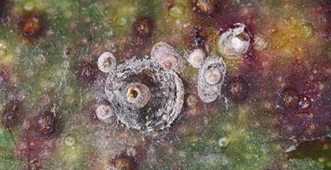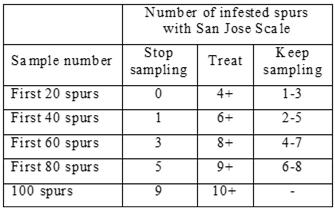Adapted from the article “Scale Pests in Prune Orchards and Keeping a Balance of Natural Enemies to Control Them” by Carolyn DeBuse, UC Farm Adviser, Solano and Yolo Counties in the October 2010 Sacramento Valley Prune News
Three scale pests are commonly found in prune orchards. San Jose scale (Diaspididae perniciosus) is generally of the most economic importance. The other two, Italian Pear scale (Epidiaspis leperii) and European Fruit Lecanium (Parthenolecanium corni), are rarely a threat to production but should still be monitored and treated if populations get too high. The dormant season is the best time to monitor the scale populations but monitoring should continue into summer and through harvest.
The best control for scale is a well-balanced population of natural enemies within your orchard. While monitoring scale you should also monitor parasites and predators of scale so that you have the complete picture when deciding if you need to treat. The chemicals you use in the orchard throughout the year can play a big role in the survival of scale’s natural enemies.
Identifying Scale

San Jose Scale. The female is round, while the male scale is oval. Photo: Jack Kelley Clark.
San Jose Scale (SJS) can be found feeding on limbs, fruit wood, spurs, leaves and fruit. Damage is caused by sucking plant juices from the plant and excreting a toxin while feeding. This can weaken the tree and scar the fruit. Female scales are round and have a hard grey covering (Figure 1, Center). Male scales are oval (Figure 1, Right) and when adult males emerge they are yellow and winged. They can be distinguished from the yellow Aphytis scale parasitoid by a black band across the abdomen. First instar crawlers are yellow and are very small.
European Fruit Lecanium (aka brown apricot scale) is a large domed soft scale that lays its eggs under the cover of the female scale. Italian Pear Scale is the smallest scale and is often difficult to see because they hide under lichen. You can identify them by scraping the lichen off and seeing the reddish brown female scale bodies underneath.
Monitoring and Treatment
Scale is best monitored in the dormant season by spur sampling. Collect 100 spurs from the orchard, choosing older spurs from the interior of the tree. Look for scale using a hand lens or dissecting microscope. Count scale infested spurs and also look for parasitized scale. This is indicated by a small exit hole on the top of the scale. If in the first 20 spurs, 4+ infested spurs are found, treatment is needed. If fewer than 4 infested spurs are found, continue looking at the next 20 spurs. See Table 1 for treatment thresholds.

Table 1. Treatment Thresholds for San Jose scale (Source: UC IPM guidelines, www.ipm.ucanr.edu).
Since you have already collected the spurs, check for aphid eggs, too. If any aphid eggs are found then a dormant treatment is recommended. See here and here for more information on aphids.
Monitoring and Preserving Natural Scale Enemies
Although treatment is sometimes needed when the scale infestation is heavy, more often the naturally found scale predators (lady beetles and lace wings) and parasitoids (Aphytis spp. and Encarsica permiciosi) keep the scale population under control. Natural enemies help reduce pesticide use so promoting the best conditions for them to thrive by carefully thinking out all aspects of pesticide choice will be time saving and economical in the long run. Timing of pesticide use and the type of pesticide you choose can negatively affect the natural balance between the scale and its enemies. Go here for a summary of the impacts of pesticides to these predators. Generally, dormant and bloom sprays have the least effect and in-season sprays can do the most harm, but this varies by material. Sprays applied in-season can affect parasitoid populations and may increase the need to monitor and treat for scale next year.


Leave a Reply